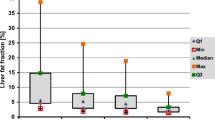Abstract
Background
Roux-en-Y gastric bypass (RYGB) result in a marked reduction of body fat and also visceral fat (VF) decrease up to 36 % in 16 weeks. This leads to positive effects on cardiometabolic risks, which are known to be correlated with the occurrence of VF. This study analyzed the validity of bioelectrical impedance analysis (BIA) for determining VF in the postoperative course. In addition, magnetic resonance imaging (MRI) was performed for prediction of whole VF in bariatric patients on the basis of a single slice.
Methods
Eighteen patients, who underwent RYGB (18), were included in this study. MRI and BIA measurements were performed 1 day before surgery, as well as 6, 12, and 24 weeks after surgery.
Results
During the postoperative observation period, we found a significant decrease of both subcutaneous fat (SF) and VF. SF measured by MRI was highly correlated with the level of body fat shown by BIA. In contrast, the VF volume, as determined by MRI, showed no correlation with the body fat measured by BIA. In addition, we were able to show a significant correlation between MRI measured VF volume and the particular single-layer fat area.
Conclusions
Compared to the widely used bioelectrical impedance analysis to measure changes in body composition after bariatric procedures, a single-layer MRI was superior in determining VF. Single-layer MRI may be a better tool to recognize changes of VF after bariatric procedures.





Similar content being viewed by others
References
Buchwald H, Oien DM, Metabolic/Bariatric Surgery Worldwide 2011; Obes Surg. 2013 Jan 22 (Epub ahead of print)
Buchwald H, Avidor Y, Braunwald E, et al. Bariatric surgery a systematic review and meta-analysis. JAMA. 2004;292:1724–37.
Fox CS, et al. Abdominal visceral and subcutaneous adipose tissue compartments: association with metabolic risk factors in the Framingham Heart Study. Circulation. 2007;116(1):39–48.
Christou NV, MacLean LD. Effect of bariatric surgery on long-term mortality. Adv Surg. 2005;39:165–79.
Sjöström L, Narbro K, Sjöström CD, et al. Effects of bariatric surgery on mortality in Swedish obese subjects. N Engl J Med. 2007;357(8):741–52.
Madan AK, Kuykendall 4th S, Orth WS, et al. Does laparoscopic gastric bypass result in a healthier body composition? An affirmative answer. Obes Surg. 2006;16:465–8.
Wildman RP, Muntner P, Reynolds K, et al. The obese without cardiometabolic risk factor clustering and the normal weight with cardiometabolic risk factor clustering: prevalence and correlates of 2 phenotypes among the US population (NHANES 1999-2004). Arch Intern Med. 2008;168(15):1617–24.
Kaess BM, Pedley A, Massaro JM, et al. The ratio of visceral to subcutaneous fat, a metric of body fat distribution, is a unique correlate of cardiometabolic risk. Diabetologia. 2012;55:2622–30.
Kyle UG, et al. Bioelectrical impedance analysis-part II: utilization in clinical practice. Clin Nutr. 2004;23(6):1430–53.
Dixon WT. Simple proton spectroscopic imaging. Radiology. 1984;153(1):189–94.
Shen W et al. Visceral adipose tissue: relations between single-slice areas and total volume. Am J Clin Nutr. 2004;80(2):271–8.
Graziani F et al. Cardiovascular risk in obesity: different activation of inflammation and immune system between obese and morbidly obese subjects. Eur J Intern Med. 2011;22(4):418–23.
Sironi AM et al. Impact of increased visceral and cardiac fat on cardiometabolic risk and disease. Diabet Med. 2012;29(5):622–7.
Matsuzawa Y, Funahashi T, Nakamura T. The concept of metabolic syndrome: contribution of visceral fat accumulation and its molecular mechanism. J Atheroscler Thromb. 2011;18(8):629–39.
Hiuge-Shimizu A et al. Reduction of visceral fat correlates with the decrease in the number of obesity-related cardiovascular risk factors in Japanese with Abdominal Obesity (VACATION-J Study). J Atheroscler Thromb. 2012;19(11):1006–18.
Patel P, Abate N. Body fat distribution and insulin resistance. Nutrients 2013;5(6):2019–27.
Neeland IJ, et al. Associations of visceral and abdominal subcutaneous adipose tissue with markers of cardiac and metabolic risk in obese adults. Obesity (Silver Spring). 2013;21(9):E439–47.
Thomson R, Brinkworth GD, Buckley JD, et al. Good agreement between bioelectrical impedance and dual-energy X-ray absorptiometry for estimating changes in body composition during weight loss in overweight young women. Clin Nutr. 2007;26(6):771–7.
Haroun D, Croker H, Viner RM, et al. Validation of BIA in obese children and adolescents and re-evaluation in a longitudinal study. Obesity (Silver Spring). 2009;17(12):2245–50. doi:10.1038/oby.2009.98.
Peterli R, Steinert RE, Woelnerhanssen B, et al. Metabolic and hormonal changes after laparoscopic Roux-en-Y gastric bypass and Sleeve Gastrectomy: a randomized, prospective trial. Obes Surg. 2012;22(5):740–8.
Wagner DR. Ultrasound as a tool to assess body fat. J Obes. 2013;2013:280713.
Mahabadi AA, et al. Association of pericardial fat, intrathoracic fat, and visceral abdominal fat with cardiovascular disease burden: the Framingham Heart Study. Eur Heart J. 2009;30(7):850–6.
Vega GL, et al. Influence of body fat content and distribution on variation in metabolic risk. J Clin Endocrinol Metab. 2006;91(11):4459–66.
Zhou A, Murillo H, Peng Q. Impact of partial volume effects on visceral adipose tissue quantification using MRI. J Magn Reson Imaging. 2011;34(6):1452–7.
Browning LM et al. Measuring abdominal adipose tissue: comparison of simpler methods with MRI. Obesity Facts. 2011;4(1):9–15.
Shen W, Chen J, Gantz M, et al. A single MRI slice does not accurately predict visceral and subcutaneous adipose tissue changes during weight loss. Obesity (Silver Spring). 2012;20(12):2458–63.
Conflict of Interest
None of the authors have anything to disclose, there are no conflict of interest.
Author information
Authors and Affiliations
Corresponding author
Rights and permissions
About this article
Cite this article
Otto, M., Färber, J., Haneder, S. et al. Postoperative Changes in Body Composition—Comparison of Bioelectrical Impedance Analysis and Magnetic Resonance Imaging in Bariatric Patients. OBES SURG 25, 302–309 (2015). https://doi.org/10.1007/s11695-014-1382-z
Published:
Issue Date:
DOI: https://doi.org/10.1007/s11695-014-1382-z




